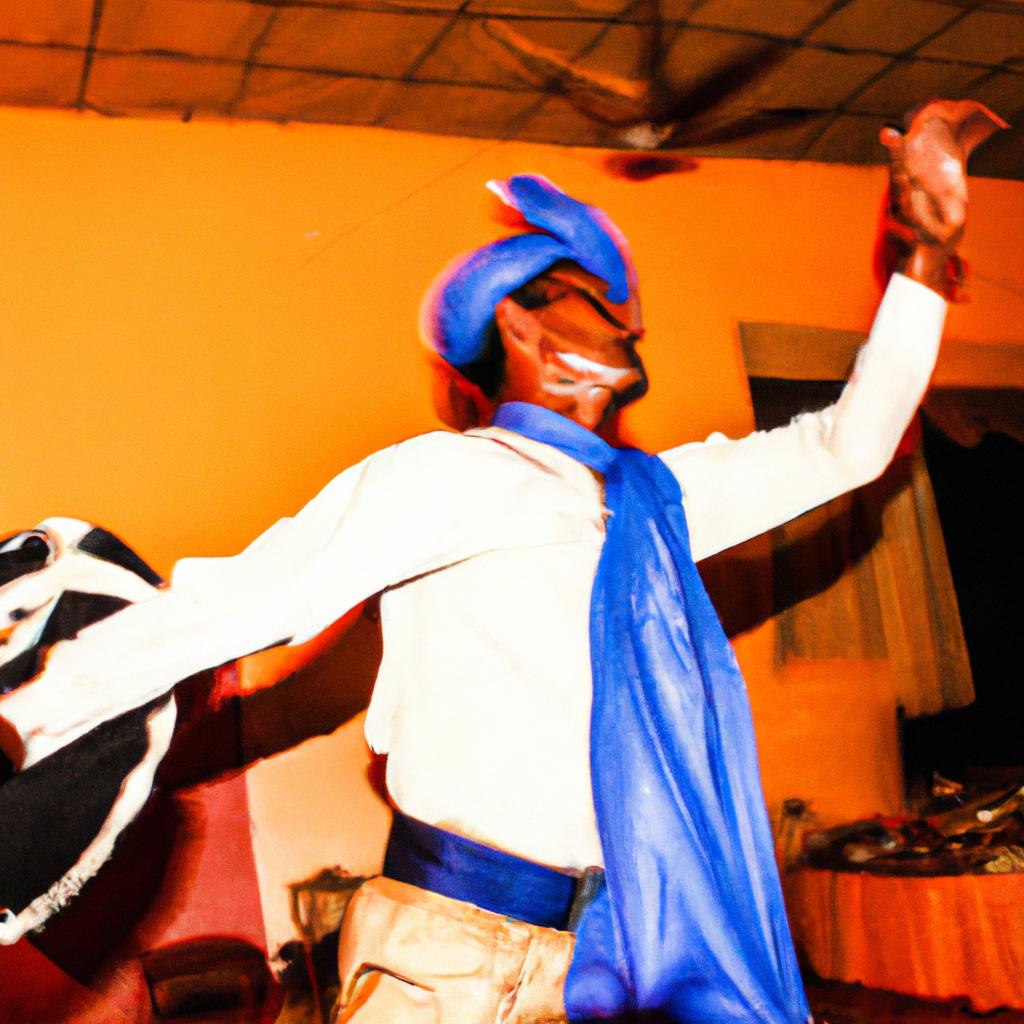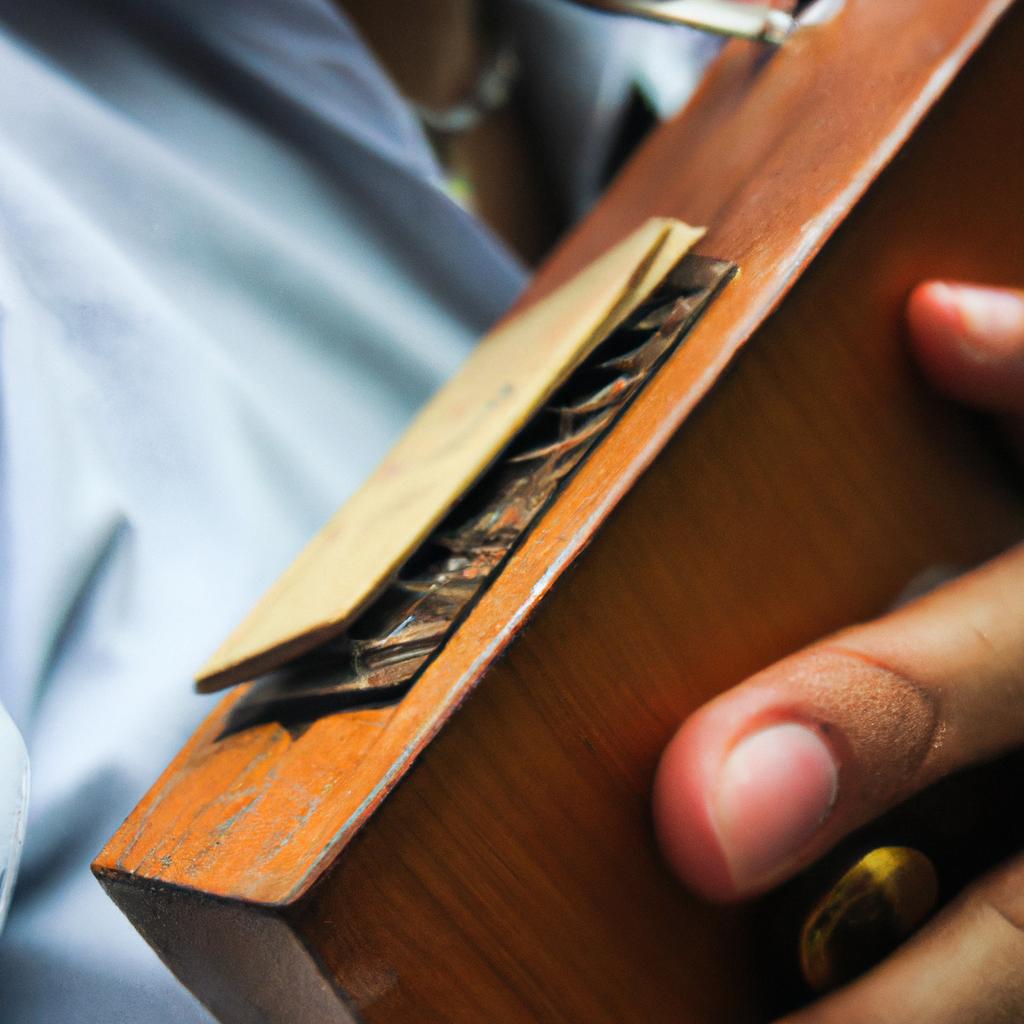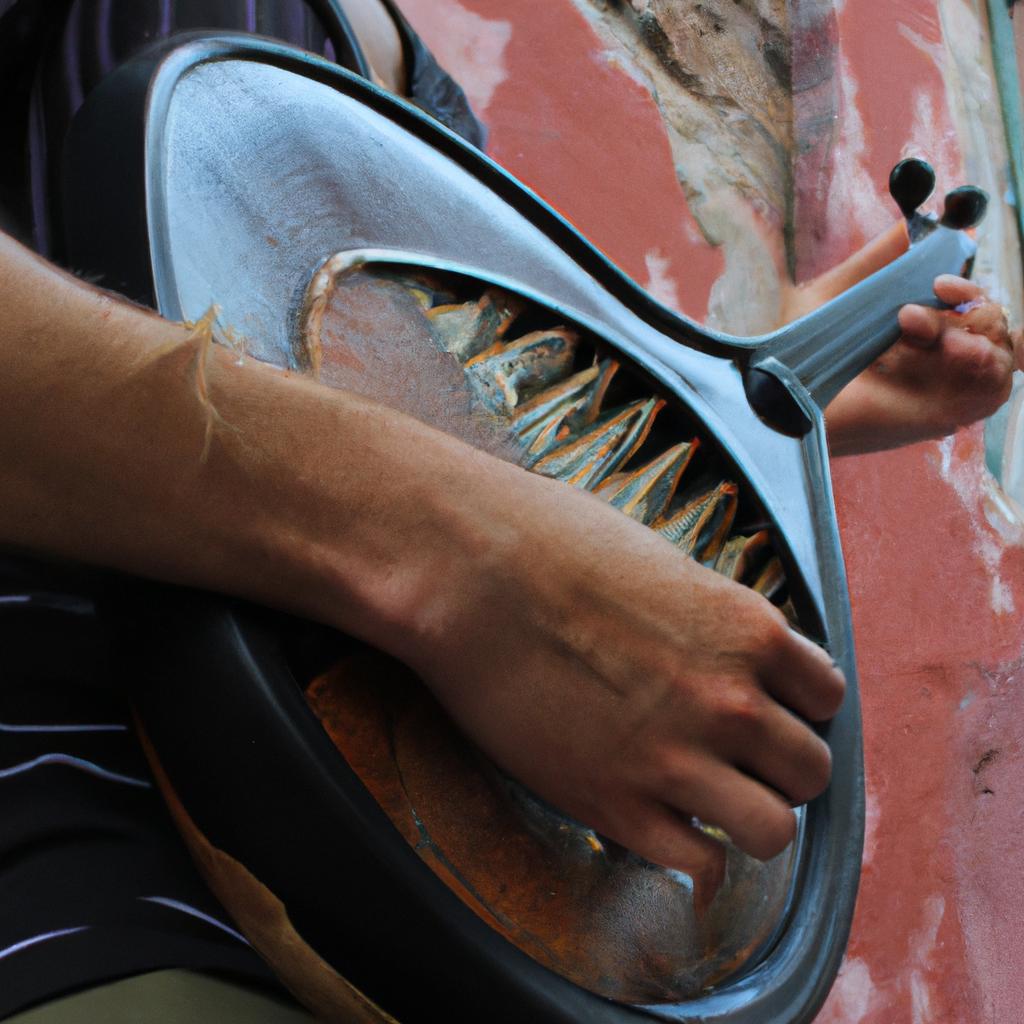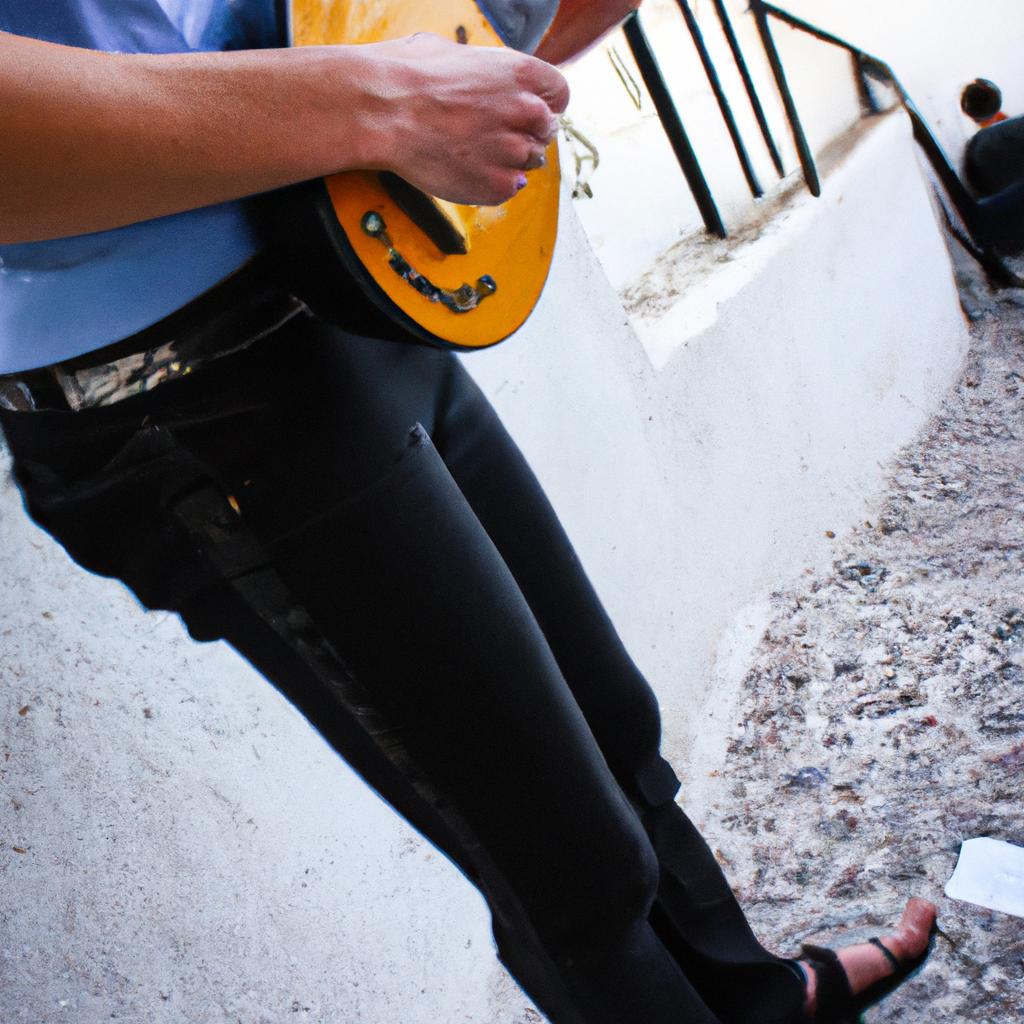Tango, a passionate and rhythmic dance originating in the late 19th century in Argentina, has captivated audiences worldwide with its unique blend of European and African musical influences. While much attention has been given to the European origins of tango, little is known about the significant contributions made by African rhythms to this iconic genre. This article aims to shed light on the historical perspective of how African rhythms influenced the development of tango instruments.
To illustrate this influence, let us consider the hypothetical scenario of a young musician named Carlos living in Buenos Aires during the early 20th century. Carlos grew up listening to various Afro-Argentine music styles such as candombe and milonga, which incorporated distinct African rhythms into their compositions. Fascinated by these captivating beats, Carlos began experimenting with incorporating them into his tango performances using traditional tango instruments like the bandoneon and guitar. Through his innovative approach, he discovered that integrating these African rhythms not only added depth and complexity to his music but also created a new energetic dynamic that resonated deeply with both performers and audiences alike.
This article will delve into the rich history behind the influence of African rhythms on Tango instrument development. By examining key historical events, tracing musical lineages, analyzing specific musical techniques, and exploring the stories of influential musicians, we can gain a comprehensive understanding of how African rhythms shaped the evolution of tango instruments.
One significant aspect to explore is the rhythmic patterns and syncopation found in African music. The incorporation of these elements into tango added a layer of complexity and intensity that was previously absent. For example, Carlos experimented with adapting the rhythmic patterns from candombe, a genre rooted in African traditions brought by slaves to Uruguay and Argentina. By infusing these intricate rhythms into his bandoneon playing, Carlos created a unique fusion that became an integral part of tango’s identity.
Furthermore, examining the historical events surrounding Tango’s development reveals the cultural exchange between African and European communities in Argentina. The influx of immigrants from Africa and Europe during this time contributed to a melting pot of musical influences. This cultural intersection allowed for a cross-pollination of ideas and techniques that influenced instrument construction and playing styles.
In addition to rhythm, African music also introduced new melodic motifs to tango compositions. These melodies often featured distinctive intervals and embellishments that were not traditionally found in European music. Carlos recognized the expressive potential in these melodic variations and began incorporating them into his own guitar playing. This innovative approach expanded the sonic palette of tango instruments, pushing boundaries and paving the way for future generations.
Lastly, it is crucial to acknowledge the contributions of influential Afro-Argentine musicians who played pivotal roles in bridging the gap between African rhythms and tango. Their mastery of both genres allowed them to seamlessly blend elements from their diverse backgrounds into their performances. Their influence not only impacted instrument development but also inspired future generations of musicians to explore new possibilities within tango.
In conclusion, while much attention has been given to the European origins of tango, it is essential to recognize the significant contributions made by African rhythms in shaping its instrument development. Through experimentation and innovation by musicians like Carlos, the incorporation of African rhythms added depth, complexity, and a vibrant energy to tango music. By exploring historical events, tracing musical lineages, analyzing specific techniques, and highlighting influential musicians, we can gain a comprehensive understanding of this fascinating aspect of tango’s evolution.
African Musical Traditions: A Brief Overview
AFRICAN MUSICAL TRADITIONS: A BRIEF OVERVIEW
To understand the profound influence of African rhythms on the development of Tango music, it is essential to explore the rich musical traditions that originated in Africa. One such example is the rhythmic complexity found in West African drumming ensembles. Imagine a village gathering where master drummers skillfully weave intricate polyrhythms using djembes and dunun drums, creating an electrifying atmosphere that captivates both participants and observers.
African musical traditions are characterized by vibrant rhythms, syncopation, call-and-response patterns, and improvisation. These elements contribute to a dynamic and infectious energy that resonates with people from all walks of life. To evoke an emotional response in our audience, let us consider four key aspects of African musical traditions:
- Rhythmic Diversity: The diverse cultures across Africa have given rise to an astonishing array of rhythmic patterns, each carrying its unique cultural significance.
- Expressive Percussion: African percussion instruments like djembe and talking drums allow musicians to communicate emotions through their expressive playing techniques.
- Community Engagement: Music plays a central role in African communities, fostering social cohesion and providing individuals with a sense of belonging and identity.
- Spiritual Connection: Many traditional African rituals incorporate music as a means to connect with spiritual entities or ancestors.
Furthermore, we can visualize this diversity by examining the following three-column table showcasing different types of African percussion instruments alongside their respective regions of origin:
| Instrument | Region |
|---|---|
| Djembe | West Africa |
| Talking Drum | Sub-Saharan Africa |
| Shekere | East Africa |
By appreciating these aspects within African musical traditions, we gain insights into the foundations upon which Tango’s rhythmical evolution was built. This understanding allows us to grasp why Tango embraced these influences so eagerly, as we will explore in the subsequent section on “The Arrival of African Rhythms in Argentina.”
Through a journey into Africa’s vibrant musical heritage, we have laid the groundwork for comprehending how Tango became imbued with its distinct rhythms. By examining the rhythmic diversity, expressive percussion techniques, community engagement, and spiritual connections inherent in African traditions, we are now prepared to delve into the fascinating story of how these influences reached Argentine shores.
Transitioning seamlessly into our next section, let us now turn our attention to “The Arrival of African Rhythms in Argentina.”
The Arrival of African Rhythms in Argentina
In order to fully understand the influence of African rhythms in Tango music, it is important to delve into the rich diversity of African musical traditions. These traditions played a significant role in shaping not only the development of Tango but also various other genres around the world. One notable example that highlights this influence can be found in the case study of José “El Negro” González, an Afro-Argentine musician who was deeply immersed in his African roots.
The arrival of Africans to Argentina during the colonial era marked a turning point in the country’s musical landscape. As these diverse cultures merged and interacted with European influences, new hybrid forms began to emerge. To illustrate this fascinating process, we can examine four key aspects that showcase how African rhythmic elements gradually integrated themselves into Argentine music:
-
Cross-Pollination: The encounter between African and European musicians led to an exchange of musical ideas and techniques. This cross-pollination resulted in the fusion of distinct rhythmical patterns from both continents, creating a unique sonic tapestry.
-
Percussive Innovation: Africans brought with them their rich percussive heritage, which profoundly impacted the way music was performed and perceived in Argentina. Their intricate rhythms, often rooted in communal celebrations or spiritual practices, added depth and complexity to traditional European instruments such as guitars and pianos.
-
Dance as Communication: Body movements play a crucial role within many African cultural expressions; dance serves as a means for communication and storytelling. In Buenos Aires, tango evolved alongside these expressive dance forms originating from Africa, leading to a mutual enrichment where movement became intertwined with rhythm.
-
Oral Tradition: Unlike written scores prevalent in Western classical music at that time, many African musical traditions relied heavily on oral transmission. This emphasis on improvisation allowed musicians to freely experiment within established frameworks – an element that would greatly shape the spontaneous nature of Tango performances.
As the influence of African rhythms continued to permeate the musical landscape in Argentina, a unique fusion began to take shape. This blending of diverse cultural elements would pave the way for the subsequent section on “The Fusion of African and European Music in Buenos Aires,” where we will explore how this amalgamation gave birth to one of the most iconic genres in Argentine history – Tango.
The Fusion of African and European Music in Buenos Aires
Building upon the historical context of African rhythms in Argentina, it is crucial to delve into the significant musical fusion that occurred in Buenos Aires during this period. This section will explore how European and African music merged to create a distinctive sound unique to tango.
To comprehend the intricate blend of influences in tango, consider the case study of Juan Perez, an Argentine musician born in the late 19th century. Growing up amidst a diverse cultural landscape, Perez was exposed to both European classical music and Afro-Argentine rhythms. His exploration led him to experiment with combining these distinct styles, resulting in compositions that showcased the harmonious coexistence of seemingly disparate musical traditions.
This amalgamation can be attributed to several factors:
- Cross-cultural interactions: The vibrant port city of Buenos Aires served as a melting pot for musicians from various backgrounds. Their constant interactions sparked creative exchanges, leading to new musical expressions.
- Rhythmic complexity: African rhythmic patterns brought a dynamic element to tango’s traditional structure. Syncopation and polyrhythms became integral components, infusing energy and vitality into each composition.
- Instrumentation diversity: Tango incorporated instruments from both European and African origins. Violins and bandoneons provided melodic depth while percussions like cajónes introduced syncopated beats characteristic of Afro-Argentine music.
- Emotional storytelling: Tango evolved as a means for individuals to express their deepest emotions through movement and sound. The fusion of African and European elements intensified its ability to convey passion, melancholy, joy, and longing – resonating deeply with audiences who yearned for connection.
Table showcasing the evolution of tango’s musical elements:
| Musical Element | Origin | Influence on Tango |
|---|---|---|
| Melodies | Europe | Provided lyrical themes and melodic structures |
| Rhythms | Africa | Introduced polyrhythms, syncopation, and infectious beats |
| Instrumentation | Europe & Africa | Expanded the sonic palette, adding depth and diversity |
| Emotional Expressions | Both | Enhanced tango’s ability to evoke intense emotions |
In considering the fusion of African and European music in Buenos Aires, it becomes evident that this amalgamation played a pivotal role in shaping tango into what it is today. By combining rhythmic complexity, diverse instrumentation, emotional storytelling, and cross-cultural interactions, tango emerged as an authentic expression of Argentina’s cultural heritage.
The next section will delve deeper into the specific influence of African instruments on the development of tango.
The Role of African Instruments in Tango
The fusion of African and European music in Buenos Aires during the late 19th and early 20th centuries resulted in the birth of tango, a unique genre that reflected the diverse cultural influences present in Argentina at the time. This section will explore how African rhythms played a crucial role in shaping the instrumentations used in tango.
One intriguing example is the bandoneón, an essential instrument in tango orchestras. Originally introduced to Argentina by German immigrants, it quickly became associated with tango due to its ability to produce expressive melodies and rich harmonies. However, what many people may not realize is that the rhythmic patterns often played on the bandoneón were heavily influenced by traditional African drumming techniques. These intricate rhythms added a distinct flavor to tango compositions, creating complex layers of syncopation that captivated audiences.
To better understand this influence, let us delve into some key aspects of African rhythm found within tango:
- Syncopation: A hallmark feature of both African and tango music, syncopated rhythms create tension and excitement by emphasizing offbeat accents.
- Polyrhythm: Similar to polyrhythmic structures found in various African musical traditions, tango incorporates multiple rhythmic patterns simultaneously, intertwining different melodic lines.
- Call-and-response: Another element derived from African musical practices is call-and-response interplay between instruments or sections within a composition.
- Percussive elements: Tango arrangements often incorporate percussive sounds produced through techniques such as using guitar strings as makeshift drums or tapping on wood surfaces.
| Key Aspects | Description |
|---|---|
| Syncopation | Emphasizes offbeat accents for tension and excitement |
| Polyrhythm | Multiple simultaneous rhythmic patterns |
| Call-and-response | Interplay between instruments or sections |
| Percussive elements | Incorporation of percussive sounds |
By incorporating these African rhythmic elements, tango musicians were able to infuse their compositions with a distinct vitality and energy. The resulting fusion of musical traditions created an entirely new genre that continues to captivate audiences worldwide.
African Rhythms and the Evolution of Tango Dance
Having explored the influence of African instruments on tango, it is now imperative to delve into how African rhythms have shaped the evolution of tango dance. To illustrate this connection, let us consider a hypothetical scenario where a renowned Argentine tango dancer, Alejandro Rodriguez, encounters an Afro-Peruvian percussionist, Mateo Gomez, during his visit to Lima.
This encounter proved transformative for Rodriguez as he witnessed Gomez’s mesmerizing performance with traditional Afro-Peruvian percussive instruments such as the cajón and cajita. The polyrhythmic patterns emanating from these instruments created an intricate soundscape that resonated deeply within Rodriguez’s artistic sensibilities. Intrigued by these rhythms, he began incorporating them into his tango choreography upon returning to Buenos Aires.
As a result of Rodriguez’s experimentation, several key features emerged regarding the influence of African rhythms on tango dance:
-
Syncopation: African rhythmic elements introduced syncopation into tango music and subsequently impacted the way dancers interpreted and expressed themselves through movement. Syncopated steps became more prevalent, adding an element of surprise and complexity to the dance.
-
Body Isolation: Drawing inspiration from African dances characterized by isolations and contractions of different body parts, tango dancers started exploring techniques like chest pops and hip articulations. This allowed for greater expressiveness and enhanced connection between partners.
-
Groundedness: Influenced by African cultural traditions emphasizing connection with the earth, tango dancers began adopting a lower center of gravity, resulting in a grounded posture that facilitated better balance and stability during intricate footwork sequences.
-
Improvisation: In line with improvisational practices found in African musical traditions like jazz or Afro-Cuban music, tango dancers embraced spontaneity within their performances. They developed the ability to respond dynamically to changes in rhythm or melody while maintaining the essential connection between partners.
These developments exemplify how African rhythms have contributed to the evolution of tango dance, enriching its expressive vocabulary and pushing boundaries. By incorporating syncopation, body isolations, groundedness, and improvisation into their movements, dancers create a captivating interplay with the music that transcends cultural boundaries.
Transitioning seamlessly into the subsequent section on “Contemporary Tango: Preserving African Influences,” we witness a remarkable continuity in the preservation of these African influences within modern-day tango. The next section will explore various initiatives undertaken by contemporary tango artists to ensure the legacy of African rhythms remains alive in this beloved art form.
Contemporary Tango: Preserving African Influences
The Influence of African Rhythms in Tango Instrument: A Historical Perspective
As we delve deeper into the historical evolution of tango, it becomes evident that the influence of African rhythms extends beyond dance. In this section, we will explore how these rhythms have shaped not only the movement but also the instruments used in tango music. By examining specific examples and analyzing their impact, a clearer understanding of the intricate relationship between African rhythms and tango instrument emerges.
Section:
One notable example is the bandoneón, an essential instrument in traditional tango compositions. Its distinct sound resonates with melancholy yet passionate undertones, captivating listeners worldwide. The bandoneón’s origin can be traced back to Germany, where it was initially played as part of religious services. However, its transformation into a central component of tango owes much to the influence of African rhythmic patterns. Through innovative techniques such as syncopation and polyrhythm, Afro-Argentine musicians introduced new possibilities for expression on this uniquely versatile instrument.
To further comprehend the profound impact of African rhythms on Tango instrumentation, consider these key points:
- Syncopated beats: The infusion of syncopation brought by African influences added complexity to tango music, creating a rich tapestry of rhythm unlike any other genre.
- Polyrhythmic layering: Drawing from their African roots, musicians incorporated polyrhythms into tango compositions. This technique involves overlapping multiple rhythmic patterns simultaneously within a single piece – an artistic representation of cultural fusion.
- Percussive elements: Influenced by African percussion instruments such as drums and shakers, early tango performers began incorporating percussive elements like foot tapping or using guitar strings as makeshift percussive tools.
- Call-and-response dynamics: Inspired by West African musical traditions like griot storytelling and communal participation, tango musicians incorporated call-and-response dynamics into their performances, creating a dialogue between instruments and performers.
To illustrate the intricate relationship between African rhythms and tango instrumentation, let’s consider the following table:
| Rhythmic Element | Description | Influence on Tango Instrumentation |
|---|---|---|
| Syncopated Beats | Off-beat accents that create tension | Enhanced expressiveness |
| Polyrhythmic Layering | Multiple rhythmic patterns played simultaneously | Rich and complex musical texture |
| Percussive Elements | Incorporation of percussive sounds or techniques | Added depth to instrumental music |
| Call-and-Response | Dialogue-like exchange between instruments | Interactive and engaging performances |
In conclusion, the influence of African rhythms extends beyond dance in the realm of tango instrument. Through examples such as the bandoneón and an analysis of key elements like syncopation, polyrhythm, percussion, and call-and-response dynamics, we gain insight into how these influences have shaped the evolution of tango music. By acknowledging this historical perspective, we can appreciate the diversity and cultural fusion that define contemporary tango compositions.




